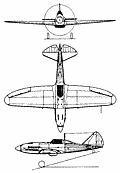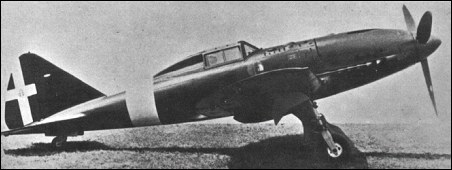|
| Last of this
related family of fighters, and one of
the best produced in Italy during
World War II, the Re.2005 Sagittario
(archer) had the same general configuration
as its predecessors. However,
its design incorporated considerable
structural redesign, and refined
landing gear, and the type reverted to
the inline engine. First flown in
September 1942 with a Daimler-Benz
DB 605A-1, the Re.2005 led to a production
model, of which deliveries began
in 1943, with a licence-built version
of this engine, the Fiat RA.1050 RC
58 Tifone. Only 48 had been delivered
before finalisation of the armistice with
the Allies, these aircraft fighting in the
defence of Naples, Rome and Sicily,
the survivors battling above the
crumbling rums of Berlin.

 | A three-view drawing (1746 x 1269) |
| lxbfYeaa, e-mail, 14.03.2024 06:37 20 reply | | Alberto Rizzi, e-mail, 27.02.2018 14:36 The last evolution of this airplane should have been the Re. 2006, with the more powerful DB 603 (1.750 CV = 1.287 kW). The well known events of Autumn 1943 compelled Reggiane to build a single prototype, used only for static trials.
Aesthetically it was very similar to the 2005, with only few aerodynamic adjustments due to the new engine. The armament remained the same, while the designers reputed (perhaps optimistically) a top speed of 750 Km /h (= 466 m.p.h.). reply | | martijn, 10.12.2015 17:33 beautifull i mean ...., i think ..eehhh.
well yuno watta i mean eyh. reply | | martijn, 10.12.2015 17:30 biutifull plane reply | |
| | Ron, e-mail, 28.06.2015 23:08 The stall speed was 96 mph, 85 with flaps.
These were hydraulically operated unlike other Italian fighters.
Does anyone know if the weakness in the landing gear and rear fuselage was strengthened? reply | | Sven, 23.06.2015 01:37 Very interesting thoughts Ron. The fact remains that if 50 of the best of the day came p against 500 easy to build Hurricanes the result would be in favour of the Hurris. Such is war. Keep posting Ron or the Wichdoctors will take over. reply | | Ron, e-mail, 22.06.2015 12:24 I like the comparison of the Ki 61 also vs the Re 2001 and 2005.
I mean, the Re 2005 with 3 CN and 2 MGs still handily out-turned all competition (the G55, MC205, Bf 109G-4, and Fw 190A-5 sans wing CN in the mock combat versions all). The Ki 61-II would be the Japanese equivalent (DB-605) to these, except for the year.
I fear the Ki 61-II Kai was overweight vs these and the Spit IX. But it had 2,000+ miles of max range and it's 4xCN version had super firepower like the Re 2005 or (4xCN Spits). So climb rate was more like the Fw 190A (4xCN version).
Considering the quantities, this is all academic but intriguing nonetheless.
The main trouble with the Re 2005 was solved by proper rebalancing of the rudder and it's dive flutter was cured. Unfortunately a few pilots had already crashed sealing it's reputation and redlining it at 500 mph when it could now do 609 mph and pull out safely. So it was largely used for training by default, after a sparkling and very active but short combat record even against Spit IXs and VIIIs. Can you imagine if Kawasaki had some of these wind-tunnel refined Sagittarios. The high man-hours were right at home in Japan vs Germany. The Ki 61-II may have become more reliable and made the best B-29 interceptor better, sooner. The 1943 Re 2005 could have offered the wing, tail and engine Kawasaki neededd to replace the Ki 61-I.
A German engine and prop example of the Re 2005 did 437 mph in level flight, much superior to the equivalent Bf 109G! But they didn't trust it's strength at such speeds (doubtless the early fatal crashes colored their judgement in part).
How fortunate for the Allies! reply | | Ron, e-mail, 18.07.2014 07:11 I meant to say MC200 not the G50.
Yes it was the best turning air superiority dogfighter despite its heavy firepower against even Spitfire Mk V and IXs, of the series 5 Italian designs at all altitudes. It had 'nice stall' at lower speeds. Quick and easy spin recovery by comparison. Superior low speed flying characteristics with 'very good' acceleration.
Cleanest aerodynamics. Good range. Great speed for 1943 at 425 mph, especially dive 582-607 mph. 500 mph limit for pilots who were not respectful of using full rudder with more touch than say a Bf 109 with its smaller rudder. Top notch dive acceleration too.
The Luftwaffe took the liberty of replacing the Italian version of the engine and prop with their own and speed rose to 435 mph at 7 Km altitude! reply | | Ron, e-mail, 18.07.2014 05:35 I heard that the Re 2005 could turn like a 2001 Ariete or a Fiat G50! Even up high it had great handling. Down low it was the best, fast too.
It had exceptional dive acceleration. reply | | Ron, e-mail, 07.03.2014 03:04 Pros: out-runs, out-turns, and-out guns a Spitfire IX at any altitude!
Cons: Hand made. Too sophisticated and refined for economic mass production.
Not robust enough for primitive unpaved airstrips.
Some vibration in the tail when diving. reply | | Ron, e-mail, 13.06.2013 01:33 Barry,
Remember the 391 mph was at about 20,000' unboosted.
At lower and also at higher altitudes it went over 420 mph in level flight. It was developed in a wind tunnel unlike the other Italian fighters in 1942-3. 980 kph dive = 609 mph, yes?
Not bad for its day when most 1942 Italian fighters were biplanes! reply | | Barry, 25.02.2013 17:51 Span 36ft 1in, Length 28ft 73 /4 in, Height 10ft 4in.
Weight empty 7,848lb
Speed 391 mph
Exceed Mach 1, I don't think so not unless you want bent propellor tips. reply | | Ron, e-mail, 30.09.2012 06:19 Can you believe sonic booms were heard by Allied pilots when Sagittarios were in a dive in combat?!
According to a P-38 Mack number, the 609 mph of the Re 2005 test dive would convert to Mach 0.924! Mach 1 becomes plausible in combat. It's not reaching that far.
I guess those combat pilots didn't get the memo yet about the 500 mph redline dive speed. reply | | Naga, 08.09.2011 06:42 According to test pilots, at high speed, combat maneuvers involving heavy rudder tended to cause the aircraft to slew violently until stabilized. Would this be a result of the thin waistline and large tail? reply | |
| | Naga, 03.09.2011 20:52 Solved my own question, it was Macchi, they developed the MC.205N Orione as a Veltro variant. I've read several books that state the 205N never saw service, but according to Aeronautica Nazionale Repubblicana archives at least three squadriglia were active with the type in late 1943. reply | | Ron, e-mail, 13.08.2011 05:43 500 mph was a dive limit for new pilots due to the tail vibration.
Other pilots who did not treat the big rudder like the small surface on other fighters, had no problem reaching 616 mph diving. reply | | beifan, 21.06.2011 05:21 Don't forget it had real teeth too, not just world class performance. Alas, if only it were a bit more sturdy and mass produced. reply | | Ron, e-mail, 03.05.2011 07:06 Naga,
Try Fiat.
As for the Re 2005 here, handling was superior to the Spitfire IX...
"having a turn radius of 639 ft (195 m) without full flaps and 487 ft (148 m) with full flaps."
Once pilots adjusted to the larger rudder ..etc, it's high speed characteristics were exemplary too.
In combat it gave better than it got even though outnumbered.
Even at high altitudes (28,000'+ arena) it could make twice the intercept firing passes on B-24s that a Macchi could, and packing more than adequate stopping power - especially vs the MC 202 armament!
It was equal to the challenge of shooting down heavy bombers or the latest fighters in stride, better than any other Italian design.
It's losses were mostly on the ground. Then the factory got bombed. reply | | Naga, 19.04.2011 21:46 Was it the Reggiane series that developed the Orione or was it Macchi? reply | | Ron, e-mail, 22.03.2011 00:41 Mid-war this plane had Bf 109G-10 (425 mph) speed with Ki 61-I maneuverability (tighter turn than Mk IX Spitfire). High altitude handling, blistering dive velocity and heavy-hitting guns. I venture to say the Italian version of the DB-605 was reliable enough (unlike the Kawasaki version). It was even run on an assembly line for the Luftwaffe for a small but unknown quantity after the Italian Armistice. Less than 50 were made before that.
All it lacked was the mass production of the Bf 109 and the sturdy build of its slower sibling Series 5 rivals from Fiat and Macchi. So it would need paved runways.
At low altitude nothing could catch it in 1943, not even a Lavochkin (421 mph @ about 6,600' or 2 km altitude).
No wonder it caught the attention of the Germans!
What if all Axis fliers had access to a world-beater like this as the French pilots did when choosing any Allied fighter in the Soviet inventory which included Spitfires and Mustangs, but the Yak was picked. Of course Yaks were the most produced single-seat fighter type during the war years. The Re 2005 was perhaps the least produced but better overall fighter. reply |
|
Do you have any comments?
|
| 
COMPANY
PROFILE
All the World's Rotorcraft
|








